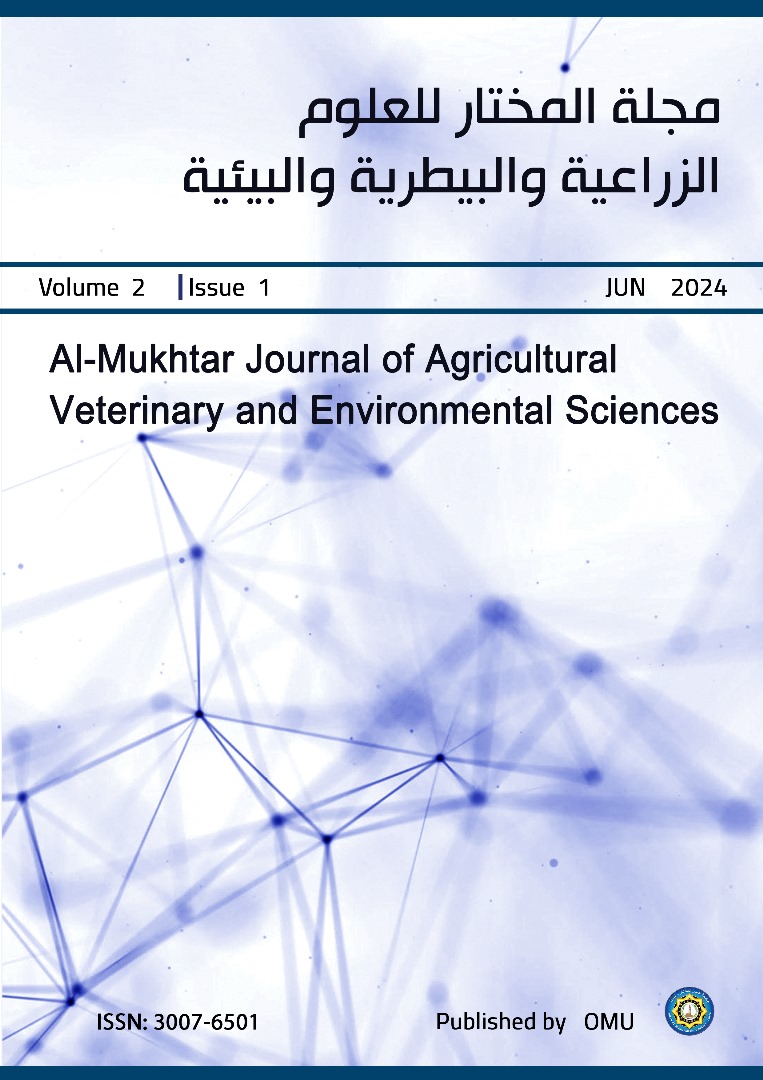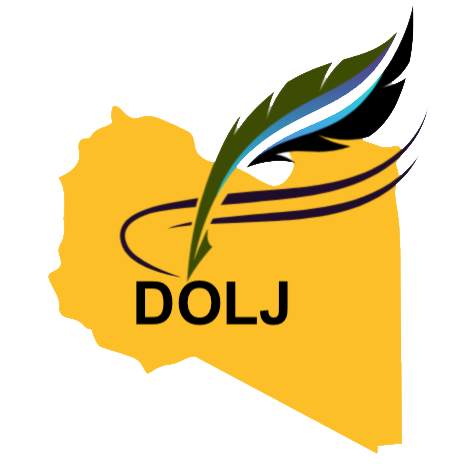تقدير البخر نتح المرجعي لمنطقة شحات في ليبيا باستخدام البرمجة الجينية
DOI:
https://doi.org/10.54172/2ma3bd67الكلمات المفتاحية:
البخر نتح المرجعي، البرمجة الجينية، معادلة الفاو بنمان مونتيث، منطقة شحاتالملخص
أجريت هذه الدراسة لتقدير البخر نتح المرجعي (ETo) لمنطقة شحات في ليبيا باستخدام البرمجة الجينية (GP) مقارنة بمعادلة الفاو بنمان مونتيث (FPM56). حيث تم استخدام البيانات المناخية لمحطة أرصاد شحات للفترة من عام 1963 وحتى عام 1999. تم استخدام ستة تركيبات مختلفة من متغيرات الأرصاد الجوية المتاحة مثل متوسط درجة حرارة الهواء(Tmean)، ومتوسط الرطوبة النسبية (RHmean)، والإشعاع الشمسي فوق الغلاف الجوي (Ra)، هذا الأخير يتم حسابه بمعرفة الموقع والتوقيت خلال السنة. تم تدريب نموذج (GP) باستخدام 70% من البيانات المناخية وتم اختباره باستخدام 30% المتبقية. بينت قيم المؤشرات الإحصائية التي تم الحصول عليها في هذه الدراسة أن الجذر التربيعي لمتوسط مربع الخطأ ومعامل التحديد ومعامل ناش-ساتكليف للكفاءة تراوحت بين 0.26 و0.98 (ملم. يوم-1)؛ 0.67 و0.98؛ 0.66 و0.98 على التوالي خلال فترة الاختبار. لذلك تمثل نماذج (GP) خياراً رائعاً لتقدير(ETo) عندما تكون البيانات المناخية شحيحة.
المراجع
Adamala, S., Raghuwanshi, N., Mishra, A., & Singh, R. (2019). Generalized wavelet neural networks for evapotranspiration modeling in India. ISH Journal of Hydraulic Engineering, 25(2), 119-131.
Adeloye, A. J., Rustum, R., & Kariyama, I. D. (2012). Neural computing modeling of the reference crop evapotranspiration. Environmental modelling & software, 29(1), 61-73.
Allen, R. G. (2000). REF-ET: Reference Evapotranspiration calculation software for FAO and ASCE standarized equatioin Version 3.1.16 for Windows. University of Idaho Research and Extension Center, Kimberly, Idaho
Allen, R. G., Pereira, L. S., Howell, T. A., & Jensen, M. E. (2011). Evapotranspiration information reporting: I. Factors governing measurement accuracy. Agricultural Water Management, 98(6), 899-920.
Allen, R. G., Pereira, L. S., Raes, D., & Smith, M. (1998). Crop evapotranspiration: guidelines for computing crop water requirements. FAO Irrigation and Drainage Paper no. 56, Rome, Italy.
Chia, M. Y., Huang, Y. F., Koo, C. H., & Fung, K. F. (2020). Recent advances in evapotranspiration estimation using artificial intelligence approaches with a focus on hybridization techniques—a review. Agronomy, 10(1), 101.
Egipto, R., Aquino, A., Costa, J. M., & Andújar, J. M. (2023). Predicting Crop Evapotranspiration under Non-Standard Conditions Using Machine Learning Algorithms, a Case Study for Vitis vinifera L. cv Tempranillo. Agronomy, 13(10), 2463.
Fogel, L. J., Owens, A. J., & Walsh, M. J. (1966). Intelligent decision making through a simulation of evolution. Behavioral science, 11(4), 253-272.
Guven, A., Aytek, A., Yuce, M. I., & Aksoy, H. (2008). Genetic programming‐based empirical model for daily reference evapotranspiration estimation. Clean–Soil, Air, Water, 36(10‐11), 905-912.
Holland, J. (1975). Adaption in Natural and Artificial Systems. Ann Arbor: University of Michigan, Press, 13.
Hrnjica, B. (2018). GPdotNET Tree based genetic programming tool, open source project. http://github.com/bhrnjica/gpdotnet
Huang, G., Wu, L., Ma, X., Zhang, W., Fan, J., Yu, X., . . . Zhou, H. (2019). Evaluation of CatBoost method for prediction of reference evapotranspiration in humid regions. Journal of Hydrology, 574, 1029-1041.
Kennedy, J. B., & Neville, A. M. (1986). Basic Statistical Methods for Engineers and Scientists (3rd ed.).
Koza, J. R. (1992). On the programming of computers by means of natural selection. In Genetic programming.
Koza, J. R. (1994). Genetic programming as a means for programming computers by natural selection. Statistics and computing, 4, 87-112.
Liu, Q., Wu, Z., Cui, N., Zhang, W., Wang, Y., Hu, X., . . . Zheng, S. (2022). Genetic algorithm-optimized extreme learning machine model for estimating daily reference evapotranspiration in Southwest China. Atmosphere, 13(6), 971.
Nash, J. E., & Sutcliffe, J. V. (1970). River flow forecasting through conceptual models part I—A discussion of principles. Journal of Hydrology, 10(3), 282-290.
Poli, R., Langdon, W., & McPhee, N. (2008). A field guide to genetic programming, Riccardo Poli, William B. Langdon, and Nicholas Freitag McPhee.
Raza, A., Fahmeed, R., Syed, N. R., Katipoğlu, O. M., Zubair, M., Alshehri, F., & Elbeltagi, A. (2023). Performance Evaluation of Five Machine Learning Algorithms for Estimating Reference Evapotranspiration in an Arid Climate. Water, 15(21), 3822.
Schwefel, H.-P. (1981). Numerical optimization of computer models. John Wiley & Sons, Inc.
Spontoni, T. A., Ventura, T. M., Palácios, R. S., Curado, L. F., Fernandes, W. A., Capistrano, V. B., . . . Rodrigues, T. R. (2023). Evaluation and modelling of reference evapotranspiration using different machine learning techniques for a brazilian tropical savanna. Agronomy, 13(8), 2056.
Wu, L., Zhou, H., Ma, X., Fan, J., & Zhang, F. (2019). Daily reference evapotranspiration prediction based on hybridized extreme learning machine model with bio-inspired optimization algorithms: Application in contrasting climates of China. Journal of Hydrology, 577, 123960.
Yamaç, S. S., & Todorovic, M. (2020). Estimation of daily potato crop evapotranspiration using three different machine learning algorithms and four scenarios of available meteorological data. Agricultural Water Management, 228, 105875.
التنزيلات
منشور
إصدار
القسم
الرخصة
الحقوق الفكرية (c) 2024 Osama A. Abdelatty , Mohamed A. Momen (Author)

هذا العمل مرخص بموجب Creative Commons Attribution-NonCommercial 4.0 International License.













